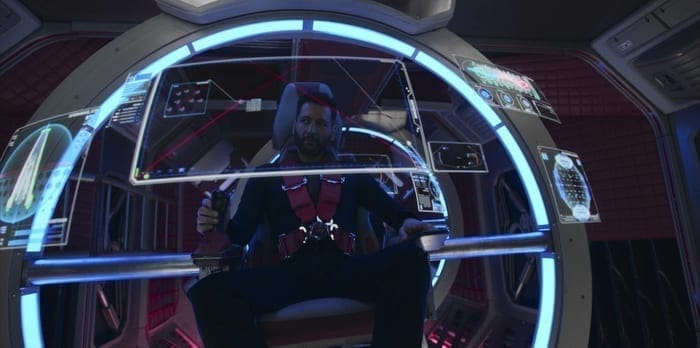“The Expanse” is Amazon Prime’s planet-hopping science fiction acquisition, currently airing its fifth season. The show takes place about two centuries in the future, where mankind has colonized the Solar System. “The Expanse” first follows an asteroid mining crew who team up with a hardboiled detective on a missing person’s investigation. Beyond this, the show weaves an intricate spacescape, tackling alien technology, exoplanets, space battles, and interplanetary politics. While the show may not be breaking wholly new ground on this subject matter, its execution is unparalleled. The show has been acclaimed by critics, but scientists have also lauded its attention to detail. Light spoilers ahead.
Space Colonization
In a little over two centuries, humankind in “The Expanse” colonized Mars, Earth’s moon, and most of the planets beyond the asteroid belt. Space colonization is a common theme in sci-fi, and “The Expanse” explores how humanity settled on Mars, asteroids, and the moon. In our world, scientists are already studying space colonization with facilities like Biosphere 2.
Located in Oracle, Arizona, Biosphere 2 was originally designed to be a completely closed ecological system, with its own rainforest, ocean, and agriculture. Biosphere 2 ran two missions in 1991 and 1994 with scientists living inside the structure. These missions studied the engineering needed to sustain life in space, but also the psychology of a crew, who would be living in isolation for months at a time. Both missions experienced massive setbacks during their duration, including lack of oxygen and persistent hunger. Despite this, the experiments still provided an understanding of the fragility of space habitation.

Photo courtesy of SYFY
In “The Expanse,” Mars is a military state hellbent on colonizing the red planet through “terraforming”. Terraforming is the mostly theoretical process of altering the geology of a planet to become sustainable for humans. Mars is home to frigid temperatures, dry ice poles, dust storms, and a toxic atmosphere. Making that atmosphere breathable is the first step in terraforming Mars. Mars’ atmospheric density is only 6 percent of Earth’s, so it needs to be thicker to match our planet’s conditions.
This seems to be the first step of the Mars Congressional Republic’s terraforming project in “The Expanse.” On the planet’s surface, large towers emit gas into the atmosphere. This may seem like a inconsequential detail, but its basis is in actual Martian geology. The soil on Mars is carbon-rich, and scientists hypothesize that burning it would release carbon dioxide. Carbon dioxide would make the atmosphere denser and heat up the planet through the greenhouse effect. While practical in theory, this idea would require a ton of energy. However, in “The Expanse,” Mars is a leader in environmental science and technology development. So, the Mars Congressional Republic’s technological advancements are therefore able to handle the planet-wide workload.
Rocket Travel and Artificial Gravity
As “The Expanse” traverses through the Solar System, it manages to portray “artificial” gravity in a really effective way. To accomplish this, the show relies on the basic principles of Newtonian mechanics. Research stations and large ships, like the Nauvoo, rely on the idea of centrifugal force. The body of a ship in space spins, causing the centrifugal force that keeps passengers’ feet planted, which simulates gravity. NASA is currently using this concept to design spaceships for manned journeys to Mars and beyond.

Photo courtesy of Amazon Studios
Smaller and faster ships in “The Expanse” utilize the idea of linear acceleration to simulate gravity. Linear acceleration works since these ships are always moving. These rockets will accelerate toward their destination, then, as the show calls it, “flip-and-burn.” At the midpoint of the trek, the ship literally flips 180 degrees and decelerates the rest of the journey. Since there are no brakes in space, this utilizes the ship’s thrust to slow it down and reach its target. During the flip-and-burn, however, the physics can get intense.
Throughout this process, the human body is under a barrage of forces. The ship has no directional motion as it flips, meaning that anyone aboard will experience weightlessness. When the engines turn back on, the amount of gravity passengers experience depends on the amount of acceleration. In quick getaways, characters experience upwards of 15G’s, or, 15 times Earth’s gravity. Forces of this magnitude are survivable, but not for extended periods of time.
Although, in order for this method to be effective, the design of the ship itself is very important. In science fiction, most rocket ships are built like submarines, where the engine is behind the vessel, pushing it forward. In “The Expanse,” ships are built more like massive skyscrapers, where the engine’s thrust is perpendicular to the ship’s floors. This arrangement mimics the force of gravity the same way accelerating in a car pushes the passenger into the seat.
Exoplanets
In the fourth season, “The Expanse” widens its scope with the introduction of new habitable worlds. The main set piece explored throughout the season is Ilus, a planet ripe for colonization. Ilus has the same gravity and atmosphere as Earth, and one day on Ilus is 34 Earth hours. Ilus is an “exoplanet”, or, any planet outside our own Solar System. In the real world, exoplanet’s pepper our universe, and ever since 1992, scientists have found over 4,000 of them. Exoplanets can be icy or covered in lava, but some are Earth-like. Astronomers find these exoplanets in a couple of different ways.
Transit photometry is the most common method, where light from a distant star is monitored for fluctuations. As an exoplanet passes in front of the star it orbits, it blocks the star’s light. For an observer on Earth, that phenomenon will look like a drop in the star’s light output. High power telescopes can measure that drop in light, which provides data on the exoplanet. For example, by studying how often that dip occurs, astronomers can deduce the planet’s orbital period. Also, the duration of the dip correlates with an exoplanet’s size.
The radial-velocity method is another way to find exoplanets. When a planet orbits a star, gravity pulls the star toward it ever so slightly. From Earth, it will appear that the star is moving toward and away from Earth on a minuscule scale. The star emits red light when it moves away from Earth and emits blue light when it moves closer. This is the Doppler Effect at work. So, if a star is emitting those colors in a pattern, it’s likely there is a planet orbiting it. While we have found a lot of exoplanets using these two methods, unlike the show, they are all very far away.
The Verdict
“The Expanse” has clearly done its homework on the science that guides our universe. While the show doesn’t get everything right, it’s definitely put the energy into trying to depict its science as accurately as possible. You can stream all seasons of “The Expanse” on Amazon Prime.
Featured image by Amazon Studios
About the Author/s
I'm a scientist obsessed with New Jersey's environment and geology. I'm probably reading science fiction. Or watering my plants.

1 comment
The article doesn’t “break down” the science behind the show, or rather the book series, it merely mentions one of the artificial gravity features (the most basic one) then mentions a few other unrelated phenomena. It’s a missed opportunity, because the novel gives a good insight into several physic issues, even though it gets wrong conclusions sometimes because it fails to quantify the results or misses some important points. It would have been interesting to develop that.
The series still has more merit than most sci-fi novels.
“ships are built more like massive skyscrapers, where the engines are perpendicular to the ship’s motion” No, the engine thrust is aligned with the ship motion, if it were perpendicular it would induce an angular momentum and the ship would rotate on itself.